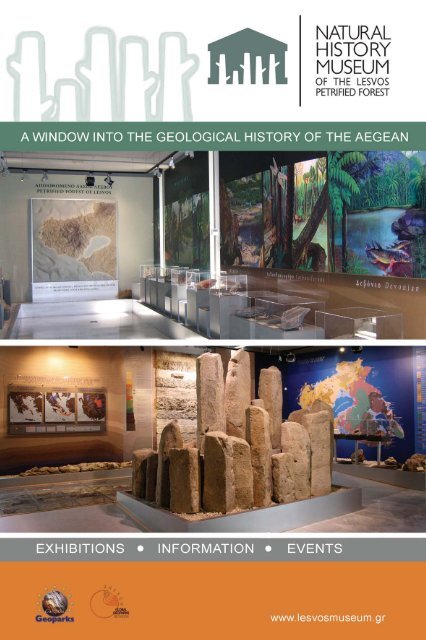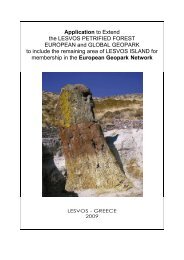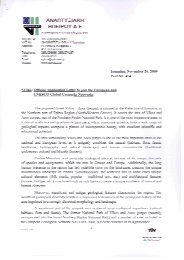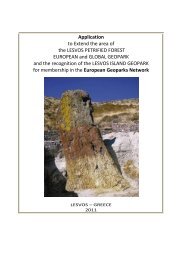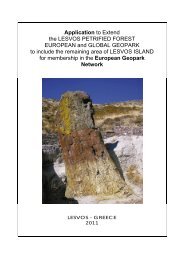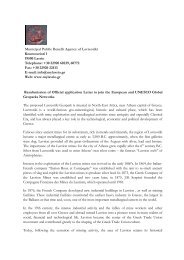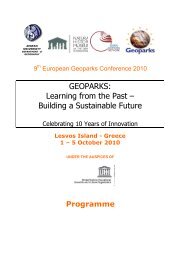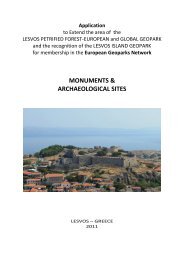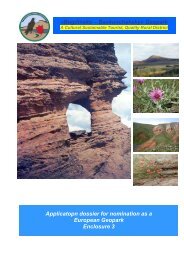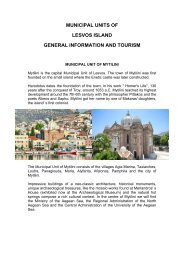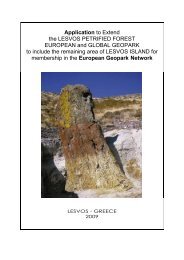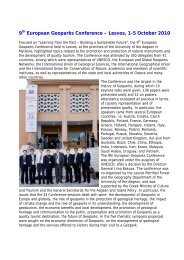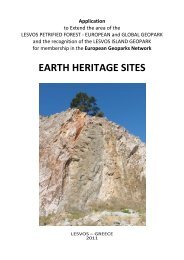ı Aggliko.qxd 10/12/2009 11:49 Page 1
ı Aggliko.qxd 10/12/2009 11:49 Page 1
ı Aggliko.qxd 10/12/2009 11:49 Page 1
Create successful ePaper yourself
Turn your PDF publications into a flip-book with our unique Google optimized e-Paper software.
ı <strong>Aggliko</strong>.<strong>qxd</strong> <strong>10</strong>/<strong>12</strong>/<strong>2009</strong> <strong>11</strong>:<strong>49</strong> <strong>Page</strong> 1
ı <strong>Aggliko</strong>.<strong>qxd</strong> <strong>10</strong>/<strong>12</strong>/<strong>2009</strong> <strong>11</strong>:50 <strong>Page</strong> 2<br />
The Natural History Museum<br />
of the Lesvos Petrified Forest<br />
A window into the geological history of the Aegean<br />
The Museum of the Lesvos Petrified Forest was established in 1994 after years of effort to<br />
save, protect and promote the fossils which constitute the Lesvos Petrified Forest.<br />
Because of its great environmental, geological and palaeontological value, the Greek state<br />
declared the area a "Protected Natural Monument". The Museum, a legal public entity under<br />
the supervision of the Ministry of Culture, aims to study, research, promote, exhibit, preserve,<br />
protect and manage any beneficial utilization of the Petrified Forest.<br />
The creation of the Museum was co-financed by the Greek state and the European Union,<br />
through the Regional Operational Program of the Northern Aegean (ROP). The project<br />
"Completion of the Natural History Museum of the Lesvos Petrified Forest" was financed by<br />
the 3rd Community Support Framework / ROP Northern Aegean (2000 - 2006) with a budget<br />
of 2,741,1<strong>49</strong> Euros. More specifically, the project included installation of a heating/cooling<br />
system, promotion and conservation work on fossils in the exhibition and outdoor areas of<br />
the Museum, special structures and equipment for the display of the fossil finds in and<br />
around the Museum, multimedia electronic equipment, construction and installation of a special<br />
permanent canopy in the Sigri Park for the protection and promotion of a fossilized root<br />
system, and special work on the protection of fossils in outdoor regions.<br />
The Museum operates with the specifications of a modern museum of the 21st century, offering<br />
visitors up-to-date information and a variety of services. It constitutes the most complete<br />
collection of fossilized plants in Greece, revolving around the most important fossils of the<br />
Lesvos Petrified Forest. For the first time, the Museum offers a well organized and thorough<br />
operation that can fully oversee the responsibility of managing the unique fossils brought to<br />
light by the continuous excavations, and educate the world about the geological processes<br />
that led to the creation of the Petrified Forest as well as the geohistoric evolution of the<br />
Aegean of the last 20 million years. As always, the operations of the Museum are tightly connected<br />
to the outdoor area of the Petrified Forest to which it continuously refers.<br />
The permanent exhibitions of the Museum offer an informative interpretation of the most<br />
important facts detailing the evolution of the landscape and life. They tell the story of the<br />
large and complex changes that led from the Aegiis landmass to the Aegean archipelago of<br />
today and allow visitors to travel back through time, inviting them to feel, contemplate and<br />
attempt to comprehend this amazing story… of this small but remarkable world.<br />
2
ı <strong>Aggliko</strong>.<strong>qxd</strong> <strong>10</strong>/<strong>12</strong>/<strong>2009</strong> <strong>11</strong>:50 <strong>Page</strong> 3<br />
The Museum Facilities<br />
The Natural History Museum of the Lesvos Petrified Forest, located in Sigri on the west coast of Lesvos,<br />
sits at the top of the village overlooking the bay and the sea beyond.<br />
The promotional efforts of the unique natural monument of the Petrified Forest are expressed in a building<br />
that successfully addresses its demanding spatial requirements and specifications with a simple and<br />
spare architectural shape that respects the natural environment. The Museum is characterized by its<br />
functional building facilities, its informative, educational and geotouristic activities, the variety of temporary<br />
exhibits and cultural events it hosts, the high quality of services and the visitor-friendly environment<br />
which includes convenient opening hours.<br />
The exhibition program, designed to present the fossils of the Lesvos Petrified Forest with modern concepts<br />
in mind, appeals to various visiting groups and is accessible to students and visitors of all ages,<br />
including expert scientists.<br />
The Museum Grounds<br />
The entrance gate to the Museum leads visitors to the outdoor exhibition grounds of the Museum. These<br />
grounds, covering an area of 1 hectare, are characterized by bushes and trees of the Lesvian flora and<br />
modern descendants of the Petrified Forest plants found in the region. Large impressive fossilized trees<br />
are also on display here. These trees are ancestral forms of gigantic sequoias and other conifers, as well<br />
as of angiosperm trees which were discovered during excavations and brought to the Museum for purposes<br />
of protection. Various trails have been designed to connect the external and internal exhibition areas,<br />
one of which leads to the Sigri Park, the neighbouring fossil-bearing region where impressive root systems<br />
have been excavated.<br />
A stairs starting from the entrance leads to the main Museum building. Covering an area of 1597 square<br />
meters, the stone structure of the Museum is built of the grey lava which abounds in the region. The<br />
Museum is fully wheelchair accessible.<br />
The Museum Building<br />
From the central entrance to the building, visitors enter the spacious atrium - an extension of the central<br />
courtyard - where the front desk ticket office and the Museum shop are located. Next to this is the pleasant<br />
snack bar with its local traditional products and a veranda with amazing views out over the Aegean<br />
sea.<br />
The interior spaces within the museum, diffused with natural light from the glass roofs and windows, are<br />
organized around a central courtyard in which impressive fossilized trunks side by side with their present<br />
day counterparts wonderfully depict the flora of the Aegean 20 million years ago.<br />
To one side of the building are the permanent exhibition areas (Petrified Forest Hall, Aegean Hall), while<br />
on the other side are the audio-visual centre, administration offices, temporary exhibit halls, library and<br />
well-equipped research labs for the preservation of fossils.<br />
The Museum also provides a 400 seat open-air amphitheatre, which is used for a variety of cultural<br />
events, theatrical shows and concerts, as well as a guesthouse to host visiting scientists and collaborators<br />
and support ongoing research.<br />
3
ı <strong>Aggliko</strong>.<strong>qxd</strong> <strong>10</strong>/<strong>12</strong>/<strong>2009</strong> <strong>11</strong>:51 <strong>Page</strong> 4<br />
4
ı <strong>Aggliko</strong>.<strong>qxd</strong> <strong>10</strong>/<strong>12</strong>/<strong>2009</strong> <strong>11</strong>:52 <strong>Page</strong> 5<br />
The Evolution of Plants and the Petrified Forest<br />
The first permanent exhibit hall of the Museum is dedicated to the Lesvos Petrified Forest. This hall<br />
displays rare plant fossils from the region of western Lesvos. Information is provided on the<br />
process of fossilization and the different types of fossils to be seen in nature. The wall screen shows<br />
visuals of the Petrified Forest Park with exceptional tree trunks, excavation work and the efforts<br />
involved in salvaging fossilized tree trunks from the sea west of Sigri. The hall is divided into 4 sections.<br />
The evolution of life on earth<br />
The first section of the Petrified Forest Hall exhibition narrates the fascinating story of the evolution of<br />
life, beginning with the appearance of the planet's first unicellular organisms 3.5 billion years ago up<br />
to the modern day ecosystems. Special attention is paid to the development of plants through a series<br />
of impressive fossilized plants which lived in different geological eras. Reconstructions of the palaeoenvironments<br />
in each geological era depict the most characteristic plants and animals which have<br />
appeared on earth.<br />
The plants of the Lesvos Petrified Forest<br />
The second section displays the most important finds revealed during excavation work in the Lesvos<br />
Petrified Forest. A map of western Lesvos presents the sites of the largest concentrations of fossilized<br />
plants on the island and the most important volcanic centers connected with the creation of the<br />
Petrified Forest.<br />
The display of the plants in the Lesvos Petrified Forest contains fascinating fossil remains of over 40<br />
different species of conifers, angiosperms or pteridophytes, the main groups of the plant kingdom. The<br />
exhibit includes petrified trunks, branches, twigs, impressive leaf imprints, fruits and parts of tree<br />
roots. The anatomical characteristics of the plants, such as the growth rings visible in trunk cross-sections,<br />
the external part of the trunk and the internal wood structure, are well preserved. There are also<br />
large pictorial depictions of the vegetation of the Petrified Forest 20 million years ago. Palms, cinnamon<br />
trees, many species of laurel, lime, beech, yew, oak, walnut, alder, blackberry, hornbeam, pines and<br />
protopinaceae, yew, thuja, cypress, cunninghamia and giant sequoia are just some of the species presented<br />
in this exhibition.<br />
The Sequoia Diorama depicts the modern sequoia trees from California, the fossils of ancestral<br />
sequoias of the Lesvos Petrified Forest and modern sequoia trunks, so that visitors are transported<br />
back in time to the subtropic forest which covered Lesvos 20 million years ago.<br />
The Marine Petrified Forest<br />
The sea to the west of Sigri contains many fossil-bearing sites. The results of the marine research are<br />
fascinating fossils which were pulled up out of the depths of the sea. These impressive petrified trunks<br />
have been cleaned of salt and marine organisms, conserved and put on display in a special area of the<br />
Petrified Forest Hall.<br />
5
ı <strong>Aggliko</strong>.<strong>qxd</strong> <strong>10</strong>/<strong>12</strong>/<strong>2009</strong> <strong>11</strong>:53 <strong>Page</strong> 6<br />
6
ı <strong>Aggliko</strong>.<strong>qxd</strong> <strong>10</strong>/<strong>12</strong>/<strong>2009</strong> <strong>11</strong>:54 <strong>Page</strong> 7<br />
The Evolution of Plants and the Petrified Forest<br />
The animals of the Lesvos Petrified Forest<br />
The first evidence of the presence of life in the Petrified<br />
Forest is displayed in a specially constructed display case<br />
containing a fossilized lower jaw of a large mammal found in<br />
the region of Gavathas, Antissa.<br />
The fossil belongs to a prehistoric form of a trunked animal<br />
(a proboscidean), which was identified by the researchers<br />
who studied it to be a representative of the Bavarian<br />
prodeinothere (species Prodeinotherium bavaricum). This<br />
animal was similar to today's elephants, but it had downward<br />
curving tusks located in the lower jawbone.<br />
The fossil is one of the oldest fossils of a vertebrate animal<br />
found until now in Greece and it comes from one of the first<br />
trunked animals which migrated from Africa (place of origin)<br />
to Europe.<br />
A reconstruction recreates the animal in the subtropical<br />
environment of western Lesvos 20 million years ago.<br />
The Petrified Forest Hall<br />
displays impressive fossils<br />
from the land and marine<br />
regions of western Lesvos<br />
(p.4-7) and important fossil-bearing<br />
sites in Greece<br />
(p.6), as well as reconstuctions<br />
of plants and ecosystems<br />
of the past. Visitors<br />
are provided with scientific<br />
guidance during their visit.<br />
Fossilized plants of Greece<br />
Besides the Lesvos Petrified Forest, fossilized plants have<br />
also been found in many other regions in Greece. Findings<br />
from the most important sites in Greece give us a picture of<br />
the evolution of vegetation in the Aegean region during the<br />
period from the creation of the Petrified Forest up until<br />
today.<br />
On display are representative fossilized plants of different<br />
geological eras, like the fossilized leaves, seeds and tree<br />
trunk segments from the regions of Evros, Limnos, Kymi<br />
and Aliveri on Evia, Vegora, Elassona and Santorini.<br />
The study of these fossils can give information on the evolution<br />
of vegetation and the climatic changes in the Western<br />
Mediterranean area over the last 30 milllion years.<br />
Particularly impressive are the finds from Santorini: fossil<br />
leaves of palm and peanut trees, as well as of olive trees<br />
which is a most rare find in the Mediterranean region, have<br />
been found in volcanic ash from the Santorini volcanic eruption<br />
50-60,000 years ago.<br />
7
ı <strong>Aggliko</strong>.<strong>qxd</strong> <strong>10</strong>/<strong>12</strong>/<strong>2009</strong> <strong>11</strong>:55 <strong>Page</strong> 8<br />
8
ı <strong>Aggliko</strong>.<strong>qxd</strong> <strong>10</strong>/<strong>12</strong>/<strong>2009</strong> <strong>11</strong>:55 <strong>Page</strong> 9<br />
The Geohistorical Evolution of the Aegean<br />
The second hall is dedicated to the geohistorical evolution of the Aegean area, highlighting geological phenomena<br />
and processes related to the system of the Earth's crust that helped create the Petrified Forest.<br />
The earth's structure, the causes and results of volcanic and seismic activity in Greece and the geological<br />
evolution of the Aegean basin during the last 65 million years are presented in six exhibit units.<br />
The structure of the Earth - Tectonic plates<br />
In the first exhibit unit, visitors are introduced to the living "Planet Earth", the planet's structure and, more<br />
specifically, to the structure of the fragile and evolving lithosphere on which life developed. The lithosphere<br />
consists of tectonic plates and their movement on the viscous asthenosphere creates volcanoes on a global<br />
scale. An impressive model portrays the process of the tectonic plate conjunction in the east<br />
Mediterranean area, the subduction of the African tectonic plate south of Crete, the transfiguration of the<br />
extended region and the creation of the active volcanic arc of the Aegean.<br />
From the Tethys to the Aegiis<br />
The second unit schematically presents the geotectonic evolution of Greece. It explains the mechanisms<br />
responsible for the rock compression in the area, the emergence of oceanic rocks from the ocean floor to<br />
the land surface and the creation of an extended landmass about 20 million years ago, which scientists<br />
today call the “Aegiis landmass”. Characteristic samples of rocks found on Lesvos that represent the two<br />
kinds of Earth's crust, the continental and the oceanic crust, are also exhibited.<br />
Silica minerals<br />
Impressive minerals and rocks are presented in the next unit. Particular emphasis is given to the presentation<br />
of natural forms of quartz (SiO 2 ), the mineral that is related to the process of petrification of plants<br />
and the creation of the Petrified Forest. On display are transparent quartz crystals, smoky quartz,<br />
amethyst, chalcedony, pink quartz, the unique green prase of Serifos Island, yellow quartz and green<br />
quartz - minerals that form impressive crystals in a great variety of colors.<br />
Volcanoes and volcanic rocks<br />
This unit is dedicated to volcanic activity. A reconstruction of the volcano of Lepetymnos, the main volcanic<br />
center that was active 16.5 to 21.5 million years ago in Lesvos, dominates the room. The presentation also<br />
includes reconstructions of different types of volcanoes, information on volcanic eruptions and their products,<br />
as well as a rich collection of volcanic rocks from Greece.<br />
Geological structure of Lesvos<br />
A large geological map of Lesvos is on display, accompanied by impressive rock samples from all the geological<br />
units of the island. A cross-section shows the layering of rocks in Lesvos. The analytic stratigraphy<br />
of the pyroclastic rocks reveals the volcanic ash horizons where fossilized trunks, roots, fruits, leaves and<br />
seeds lie perfectly preserved.<br />
9
ı <strong>Aggliko</strong>.<strong>qxd</strong> <strong>10</strong>/<strong>12</strong>/<strong>2009</strong> <strong>11</strong>:56 <strong>Page</strong> <strong>10</strong><br />
<strong>10</strong>
ı <strong>Aggliko</strong>.<strong>qxd</strong> <strong>10</strong>/<strong>12</strong>/<strong>2009</strong> <strong>11</strong>:57 <strong>Page</strong> <strong>11</strong><br />
The Geohistorical Evolution of the Aegean<br />
From the Aegiis landmass to the Aegean Sea<br />
Palaeogeographic maps of the Aegean area illustrate the development<br />
of the region over the last 25 million years. The map of<br />
the active volcanic faults of the Aegean details the current geodynamic<br />
situation and seismic activity. Screens connected to<br />
the seismological stations in Sigri and Thessaloniki display<br />
recordings of seismic waves in real time. An educational seismograph<br />
shows how seismic waves are recorded. This way,<br />
visitors can realize that the geological phenomena which created<br />
the Petrified Forest are still in action in the wider region of<br />
the Aegean.<br />
Specially made structures,<br />
models and reconstructions<br />
tell the story of the geological<br />
phenomena which shaped the<br />
Aegean region and created<br />
minerals, rocks, and fossils<br />
(p.8-<strong>11</strong>). Proof of the geohistoric<br />
evolution of the region<br />
and the life of the Aegean are<br />
presented by casts of important<br />
fossils which are kept in<br />
the Natural History Museum<br />
of Crete and the<br />
Palaeontological Museum of<br />
the Aristotle University of<br />
Thessaloniki (p.<strong>10</strong>).<br />
Life in the Aegean<br />
Geological phenomena affect and change the geography of a<br />
particular regional landscape and are decisive causes in the<br />
change and evolution of modern ecosystems. Proof of life in<br />
the Aegean and information about the animals which lived in<br />
Greece and the fossils they left behind are presented through<br />
reconstructions and fossil casts of the most representative<br />
finds of mammals in Greece, such as the gigantic deinothere<br />
from Crete (the original fossil is in the Natural History Museum<br />
of Crete) and the primitive elephant from Macedonia (the original<br />
fossil is kept in the Palaeontological Museum of the<br />
Aristotle University of Thessaloniki).<br />
The last minute<br />
The most recent period of history saw the appearance of the<br />
most developed and most complete forms of organisms. The<br />
exhibit displays cranial casts and reconstructions of the most<br />
important representative findings from North Greece, two<br />
Mesopithecus species and Ouranopithecus macedoniensis.<br />
Also on display is the cast and reconstruction of the "famous"<br />
human skull from the cave of Petralona, Halkidiki, which is one<br />
of the best preserved fossils in Europe representing an evolutionary<br />
stage between Homo erectus and the current day<br />
Homo sapiens.<br />
The exhibition ends with tools made of flint from the Lesvian<br />
Paleolithic age, which remind us of the close link between the<br />
geological structures of a region and human behaviors.<br />
<strong>11</strong>
ı <strong>Aggliko</strong>.<strong>qxd</strong> <strong>10</strong>/<strong>12</strong>/<strong>2009</strong> <strong>11</strong>:58 <strong>Page</strong> <strong>12</strong><br />
<strong>12</strong>
ı <strong>Aggliko</strong>.<strong>qxd</strong> <strong>10</strong>/<strong>12</strong>/<strong>2009</strong> <strong>11</strong>:59 <strong>Page</strong> 13<br />
Multimedia and Information Services<br />
The audiovisual room in the Museum is the first stop for visitors.<br />
Here visitors are informed, via the use of visuals,<br />
about the Petrified Forest, its creation, its uniqueness, the<br />
types of plant fossils found in the area of West Lesvos, the<br />
parks and their important concentrations of petrified tree<br />
trunks, as well as the activities of the Museum. This room is<br />
also used for audiovisual presentations on natural history<br />
topics, documentary screenings and educational presentations<br />
in the context of the educational programs. Further uses<br />
include conferences, meetings, book presentations, talks and<br />
film and documantary showings.<br />
Visitors to the Museum can also use the information services<br />
in the permanent exhibition halls and in the outdoor parks of<br />
the Petrified Forest.<br />
Informative literature, guidebooks for the Petrified Forest,<br />
albums and educational publications for the Petrified Forest<br />
(also available in electronic form) are available at the<br />
Museum shop.<br />
Interactive Applications<br />
The Museum also provides interactive multimedia applications<br />
on: a. the Petrified Forest and the evolution of life, b. volcanic<br />
activity and the process of fossilization, c. the geohistoric<br />
evolution of the Aegean region and the geological monuments<br />
created through it..<br />
The Museum has also installed various info-kiosks in the<br />
exhibition halls where visitors can explore the park using multimedia<br />
applications. These multimedia applications allow the<br />
visitor to access more information about the Petrified Forest,<br />
the evolution of life, the geological history of the Aegean and<br />
the geological heritage of Greece, via an impressive userfriendly<br />
environment that has been facilitated by modern<br />
technology.<br />
Individual Guidance System<br />
The wireless guidance system "GUIDE" provides visitors with a<br />
personal "tour guide" in the form of a palmtop which provides<br />
information on the exhibits.<br />
13
ı <strong>Aggliko</strong>.<strong>qxd</strong> <strong>10</strong>/<strong>12</strong>/<strong>2009</strong> <strong>12</strong>:00 <strong>Page</strong> 14<br />
14
ı <strong>Aggliko</strong>.<strong>qxd</strong> <strong>10</strong>/<strong>12</strong>/<strong>2009</strong> <strong>12</strong>:01 <strong>Page</strong> 15<br />
Petrified Forest Parks<br />
The Sigri Park<br />
The Sigri Park, covering an area of 3 hectares, is located next<br />
to the Museum. The park is a very interesting "geotope"<br />
because of the rarity and the great scientific worth of its plant<br />
fossils and the volcanic rock which enclosed the remains.<br />
These rocks and fossils provide information about the<br />
region's vegetation 20 million years ago, as well as the geological<br />
development and volcanic activity of the region.<br />
While walking along the pathways which have been carved<br />
out of the hillside, visitors can admire the most valuable finds<br />
within the park which are the petrified tree root systems.<br />
These root systems are well-preserved and in a full stage of<br />
development, indicating that the fossil trees are still in their<br />
original growth positions.<br />
The Plaka Sigri Park<br />
The park, covering an area of 7 hectares, was created on the<br />
Plaka peninsula, 800 meters south of the village of Sigri. The<br />
park contains an important protected fossil-bearing region.<br />
In both sections of the park, Museum researchers have excavated<br />
significant petrified remains that will intrigue the visitor.<br />
Numerous standing trunks with intact root systems and<br />
lower trunk parts have been found on the site making it a rare<br />
geotope of great natural beauty. In the coastal area of the<br />
park, visitors can view impressive honeycomb geomorphs<br />
made due to the weathering of the volcanic rock. Trails<br />
throughout the park lead visitors to all the fossil sites and<br />
they can also take advantage of the three covered viewpoints<br />
with their vistas of Sigri and the Nisiopi islet.<br />
Among the fossil finds at the park is a gigantic standing fossilized<br />
trunk with a circumference of 13.7m and a diameter of<br />
3.70m, belonging to the laurel family. According to international<br />
bibliography, this fossil is the broadest standing petrified<br />
trunk in the world. The lower section of the trunk still has<br />
part of its root system, a fact which proves that the trunk is in<br />
its original growth position. In the marine zone of the park is<br />
an impressive laying petrified trunk of an angiosperm tree,<br />
14 meters in length.<br />
15
ı <strong>Aggliko</strong>.<strong>qxd</strong> <strong>10</strong>/<strong>12</strong>/<strong>2009</strong> <strong>12</strong>:02 <strong>Page</strong> 16<br />
16
ı <strong>Aggliko</strong>.<strong>qxd</strong> <strong>10</strong>/<strong>12</strong>/<strong>2009</strong> <strong>12</strong>:02 <strong>Page</strong> 17<br />
Educational Activities<br />
Educational activities are one of the main undertakings of the Museum.<br />
Educational school programs<br />
The Museum offers educational programs on a wide range of subjects. These programs are aimed at all<br />
levels of education, with special multi-day educational programs for schools outside of Lesvos, and summer<br />
programs which attract the interest of students on Lesvos, in the rest of Greece and abroad.<br />
Participants in the educational programs of the Museum can use scientific equipment for the research<br />
and study of the fossils, the thematic museum kits, specially made educational material and interactive<br />
multimedia applications. These tools help students to learn about the creation of the Petrified Forest, the<br />
process of fossilization, geodynamic phenomena- earthquakes and volcanoes, the geohistoric development<br />
of the Aegean, the history of the evolution of life on earth and modern ecosystems. The educational<br />
seismograph and the models of different types of volcanoes familiarize children with active geodynamic<br />
phenomena, earthquakes and volcanic eruptions. Earthquake movements and volcanic eruptions are<br />
simulated with special equipment, educating participants in educational programs about the geological<br />
phenomena which they can not directly observe.<br />
The Museum has also created an educational excavation area, called "Georama", where children can<br />
become familiar with scientific research while using excavation tools and equipment to excavate plant<br />
fossils and to clean and identify them.<br />
Summer educational programs<br />
During the holidays, young friends of the Museum can get creative with some hands-on experience while<br />
participating in the summer educational programs. The "Small Paleontologists" program allows children<br />
to get to know fossils and experience the excitement of excavating them themselves.<br />
Scientific tours and fieldwork<br />
The Museum organizes educational visits and special informative programs and tours on the subject of<br />
the Petrified Forest, its geotopes and the geological history of Lesvos, and makes arrangements for<br />
organized visits of universities, scientific teams, and participants in Greek and international conferences.<br />
Every year, the Museum also organizes and hosts international conferences, scientific meetings, international<br />
post-graduate schools and other scientific activities.<br />
Summer student practicums<br />
In cooperation with the "Friends of the Petrified Forest" Association, the Museum organizes summer volunteer<br />
programs for youth and summer practicums for university students which are well attended by<br />
students from Greece and abroad.<br />
Center of Professional Training<br />
The Museum operates a Center of Professional Training to train youth from the region in matters related<br />
to the promotion, protection and management of the protected region of the Petrified Forest.<br />
17
ı <strong>Aggliko</strong>.<strong>qxd</strong> <strong>10</strong>/<strong>12</strong>/<strong>2009</strong> <strong>12</strong>:03 <strong>Page</strong> 18<br />
18
ı <strong>Aggliko</strong>.<strong>qxd</strong> <strong>10</strong>/<strong>12</strong>/<strong>2009</strong> <strong>12</strong>:03 <strong>Page</strong> 19<br />
Temporary Exhibitions and Events<br />
Temporary exhibitions and cultural events take place in the temporary exhibitions hall and in the<br />
Museum's outdoor amphitheatre throughout the year. Through these cultural activities, which use the<br />
natural history of the region as a starting point to inspire many forms of cultural creativity, the Museum<br />
is a lever of cultural development in western Lesvos.<br />
Temporary Exhibits<br />
The temporary exhibits which are hosted by the Museum feature interesting chapters of natural history<br />
which are not covered by its permanent exhibitions. Exhibitions are often invited from various European<br />
Natural History Museums with which the Museum collaborates closely. The following exhibitions were<br />
particularly successful: Crystals - Minerals of Silica (2003), The Plants of the Ancient Games (2004), The<br />
Dinosaurs of Provence (2005), The Birds of the Petrified Forest (2006), From Trilobites to Man (2006),<br />
Earthquake Risk in the Northern Aegean (2008), Plants and Tradition (2008).<br />
Summer Cultural Events<br />
Every year, during the summer months, the Museum hosts a festival with a variety of cultural events entitled<br />
"Celebrating Earth" which includes sculpture, art, pottery and craft exhibitions, book presentations,<br />
theatrical and musical shows, and film screenings. These events open the Museum to new uses and<br />
attract visitors, local and foreign.<br />
European Geoparks Week<br />
Near the end of Spring a series of events are organized which include guided tours through the Parks of<br />
the Petrified Forest, educational programs, outdoor activities involving nature observation, seminars,<br />
presentations and screenings on themes of protection and promotion of the geological and natural heritage<br />
in the Petrified Forest region. Similar events are organized simultaneously in all members of the<br />
European Geoparks Network.<br />
Agrotourism Festival<br />
Since 2000 an "Agrotourism Festival" has been held every summer highlighting the local products and<br />
the rich folk traditions of Lesvos. Recent years have seen the proliferation of women's agrotouristic cooperatives<br />
which make sweets and food products using traditional recipes and know-how, resulting in very<br />
high quality goods. Young people are also creating new businesses based on the uniqueness of traditional<br />
Lesvian products. Artistic creativity, rooted in the rich local traditions, is reviving traditional occupations<br />
such as woodcarving and pottery. The Agrotourism Festival, a fest of the fruits of the Lesvian soil,<br />
promotes initiatives that contribute to the local economy and tourism.<br />
Museum Nights<br />
As a participant in the international "Museum Nights" celebrations, the Museum remains open late into<br />
the night every Friday throughout August and selected films and documentaries are shown.<br />
19
ı <strong>Aggliko</strong>.<strong>qxd</strong> <strong>10</strong>/<strong>12</strong>/<strong>2009</strong> <strong>12</strong>:05 <strong>Page</strong> 20<br />
20
ı <strong>Aggliko</strong>.<strong>qxd</strong> <strong>10</strong>/<strong>12</strong>/<strong>2009</strong> <strong>12</strong>:05 <strong>Page</strong> 21<br />
Geoparks<br />
Geoparks are areas that comprise a<br />
certain number of protected geological<br />
monuments and geotopes of particular<br />
importance, as well as sites of<br />
ecological, cultural or aesthetic<br />
appeal, which are managed and<br />
developed for scientific research,<br />
education and recreation. The etymology<br />
of the word "geopark" refers<br />
to Gaia - the mother Earth -and to the<br />
interactive relationship among<br />
humans, the planet and the natural<br />
environment.<br />
A geopark incorporates a holistic<br />
approach for the living and abiotic<br />
environment of a region by connecting<br />
the protection and the promotion<br />
of particular features with a sustainable<br />
development strategy on a local<br />
scale. Thus, a geopark plays an<br />
active role in the economic development<br />
of its territory through the promotion<br />
of its geological heritage and<br />
the development of geotourism.<br />
Cooperations<br />
The Natural History Museum of the Lesvos Petrified Forest has<br />
developed collaborations with universities, museums,<br />
research centers and organizations managing protected regions<br />
in Greece and abroad, in order to cooperate in the realization of<br />
research and development programs. The Museum has signed<br />
program collaboration agreements with the University of the<br />
Aegean and the Environmental Education Center of Evergetoula,<br />
Lesvos. The Museum also collaborates with the universities of<br />
Athens and Thessaloniki, the Natural History Museum of Crete,<br />
the Institute of Geology and Mineral Exploration of Greece, the<br />
National Technical University of Athens, the National<br />
Observatory of Athens, the Foundation of the Hellenic World etc.<br />
European Geoparks Network<br />
The Natural History Museum of the Lesvos Petrified Forest is<br />
active internationally as a member of the European Geoparks<br />
Network and the Global Geoparks Network of UNESCO with which<br />
a great deal of collaboration occurs.<br />
The European Geoparks Network was created in 2000 with the<br />
assistance of the E.U. and the participation of four organizations<br />
from France, Germany, Greece, and Spain. The Natural History<br />
Museum of the Lesvos Petrified Forest is a founding member of<br />
the Network. In September 2008 there were 33 members in the<br />
European Geoparks Network situated in 13 European countries.<br />
Global Geoparks Network<br />
The Global Geoparks Network was established in 2004 under the<br />
aegis of UNESCO, which, thereby recogned the importance of<br />
geological formations and landscapes for the advancement of<br />
society and human civilization, and for cultural diversity on the<br />
planet. Consequently, a number of Chinese Geoparks and the<br />
European Geoparks, among them the Lesvos Petrified Forest<br />
Geopark and the Psiloritis Geopark in Crete, were included in the<br />
UNESCO Global Geoparks Network following a positive evaluation<br />
of their park operations and management. In September<br />
2008 there were 57 members in the Global Geoparks Network,<br />
situated in Europe, Asia, South America, and Australia.<br />
With its induction into the Global Geoparks Network, the Lesvos<br />
Petrified Forest has gained recognition from the international<br />
community as a priceless monument of natural heritage for all<br />
humankind.<br />
21
ı <strong>Aggliko</strong>.<strong>qxd</strong> <strong>10</strong>/<strong>12</strong>/<strong>2009</strong> <strong>12</strong>:06 <strong>Page</strong> 22<br />
Museum Access<br />
The Natural History Museum of the Lesvos Petrified Forest is<br />
located in Sigri, 96 km from Mytilene.<br />
Visitors can get to the Museum via the local bus service<br />
(KTEL), organized tours arranged by tourist offices during<br />
the summer, and by taxi.<br />
Information<br />
The Museum informs the public of its activities through the<br />
press, its “Sequoia” magazine which is published four times a<br />
year, informative brochures and mainly through its website.<br />
Website: www.lesvosmuseum.gr<br />
Available in three languages, the Museum's website was<br />
designed to satisfy the demands of the end user.<br />
Through the provision of information and services, the website<br />
represents an essential tool of direct communication<br />
between the Museum and the user. Attractive and userfriendly,<br />
the website provides access to a wide variety of<br />
pages concerning the Petrified Forest and the Museum. A significant<br />
part of the website is the database which was created<br />
to include the information on the fossils and geotopes in<br />
western Lesvos and the exhibits at the Museum.<br />
Publications<br />
The Museum has put together a series of publications, print<br />
and electronic, which include books, albums, exhibit guides,<br />
park guides of the Petrified Forest, educational publications,<br />
maps, informative magazines, brochures, promotional material<br />
and CD-ROMs. Publications are available in the Museum<br />
shop.<br />
Conference Center<br />
The Museum facilities (including the amphitheatre) are available<br />
to scientific authorities for the organization of conferences,<br />
seminars, scientific congresses and exhibitions.<br />
The conference center is equipped with up to date audio-visual<br />
facilities as well as automatic translation in two languages.<br />
Snack bar<br />
From the verandah of the Museum<br />
snack bar, visitors can enjoy the<br />
most beautiful sunset on the island!<br />
With a view of the western coastline<br />
of Lesvos and the islet of Nisiopi, the<br />
snack bar is a popular place to meet<br />
and talk. Here visitors can relax<br />
while enjoying a Greek coffee prepared<br />
on charcoal and a spoon<br />
sweet made by a Women's<br />
Agrotouristic Cooperative of Lesvos.<br />
Museum Shop<br />
At the Museum shop, visitors can<br />
find various Museum publications,<br />
fossil casts and souvenirs of the<br />
Petrified Forest.<br />
There is also a wide range of books<br />
on topics such as geology, flora and<br />
fauna, natural monuments, the<br />
environment and protected regions<br />
and publications about Lesvos.<br />
For young visitors, there are children's<br />
books, puzzles, crafts, educational<br />
material and games.<br />
Artwork from local artists are also<br />
available, along with ceramics, jewelry,<br />
sweets, olive oil, ouzo, and<br />
other products produced by the<br />
Women's Agrotouristic Cooperatives<br />
and industries of the island.<br />
22
ı <strong>Aggliko</strong>.<strong>qxd</strong> <strong>10</strong>/<strong>12</strong>/<strong>2009</strong> <strong>12</strong>:06 <strong>Page</strong> 23<br />
The Natural History Museum<br />
of the Lesvos Petrified Forest,<br />
situated in Sigri, Lesvos, is a<br />
legal public entity under the<br />
supervision of the Ministry of<br />
Culture. The aims of the<br />
Museum are the study,<br />
research, promotion, exhibition,<br />
preservation, safeguarding<br />
and any beneficial utilization<br />
of the Petrified Forest, a<br />
protected natural monument.<br />
The Museum is governed by a<br />
seven-member Administrative<br />
Council and the Museum<br />
Director who are appointed<br />
by the Ministry of Culture.<br />
The Lesvos Petrified Forest is<br />
a member of the European<br />
and the Global Geoparks<br />
Network of UNESCO.<br />
<br />
<br />
@<br />
<br />
i<br />
Address: Sigri, Lesvos 81<strong>10</strong>3<br />
Telephone - Fax: 22530-54434, 225<strong>10</strong>-47033<br />
E-mail: lesvospf@otenet.gr<br />
http://www.lesvosmuseum.gr<br />
www.petrifiedforest.gr<br />
Opening hours:<br />
Summer<br />
July 1 to September 30<br />
Daily 09:00 to 20:00<br />
Friday 09:00 to 22:00<br />
Mytilene Information Center<br />
8th Noemvriou 17, Mytilene 81<strong>10</strong>0, Lesvos<br />
Telephone - Fax: 225<strong>10</strong>-47033<br />
Winter<br />
October 1 to June 30<br />
Daily 08:30 to 16:30<br />
Publication: Natural History Museum of the Lesvos Petrified Forest<br />
Editor in chief: N. Zouros<br />
Text: K. Vasileiadou, K. Bendana<br />
Layout & Design: A. Georgiou<br />
English Translation: H. Gaganis<br />
Printing: Epikoinonia S.A.<br />
COMPLETION OF THE NATURAL HISTORY MUSEUM OF THE LESVOS PETRIFIED FOREST<br />
This program was financed 85% by ERDF and 15% by state funds<br />
through ROP Northern Aegean 3rd C.S.F. (2000 - 2006)<br />
23
ı <strong>Aggliko</strong>.<strong>qxd</strong> <strong>10</strong>/<strong>12</strong>/<strong>2009</strong> <strong>12</strong>:23 <strong>Page</strong> 24


